Coding-Decoding is one of the most important, common and challenging topics seen in many Government exams like SSC, Railway, Insurance, Defence and Banking, CUET, VITEEE, MAH MBA CET, IPMAT and other competitive exams. Despite its complexity, it is a high-scoring topic when the concepts are thoroughly understood. This topic helps to improve logical reasoning skills. In this article, we will cover coding decoding concept, coding decoding reasoning formula, coding decoding reasoning tricks, coding decoding reasoning questions with answers etc. As the MAH MBA CET is approaching, students can attempt the latest Free Mock Test designed for the aspirants by our experts to score a high percentile in the exam.
CAT 2024: 20 Free Mock Test | 10 Year PYQs | 60 Day Study Material | Most Scoring Concepts
XAT 2025: Section-wise Preparation Tips | Sample Paper
Don't Miss: IBSAT 2024 Mock Tests | NMAT 2024 Sample Papers | MAT 2024 Sample Papers
Question with Solutions: Missing Number | Alphabet Test | Arithmatical Problems | Calendar
- Introduction to Coding and Decoding
- Types of Coding-Decoding
- Recommended Books and Online Resources
- Question Weightage of Coding Decoding Reasoning Questions in Competitive Exams
- Practice Questions For Direct Letter Coding
- Practice Questions For Deciphering Message Word Codes
- Practice Questions For Deciphering Number and Symbol codes for messages
- Practice Questions For Deciphering number and letter codes for messages
- Practice Questions For Substitution-based coding-decoding
- Practice Questions For Chinese Coding
- Practice Questions For Jumbled Coding
- Practice Questions For Conditional Matrix
- Coding-Decoding Questions for SRMJEE/ VITEEE/ CUET
- Coding-Decoding Questions for APICET/ KMAT
- Coding-Decoding Questions for SSC-CHSL, SSC-CGL, SSC-CPO, SSC-MTS, RRB exams
- Coding-Decoding Questions for Bank IBPS CWE Clerk, IBPS RRB Clerk, SBI Assistant, Insurance Assistant exams
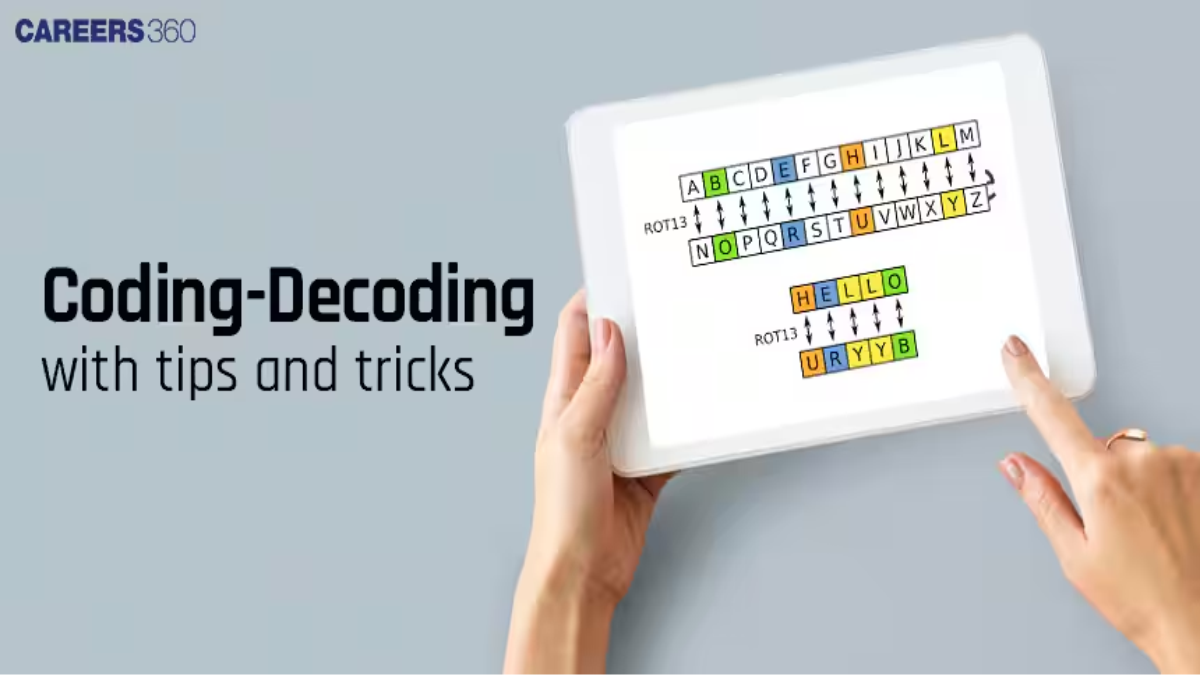
Introduction to Coding and Decoding
As the name suggests, the topic coding decoding reasoning is based on encoding a letter, a number, or a word. Coding letters, numbers, or words is based on various rules and patterns. We have to decipher the correct pattern for the coded letters, numbers or words to solve the questions.
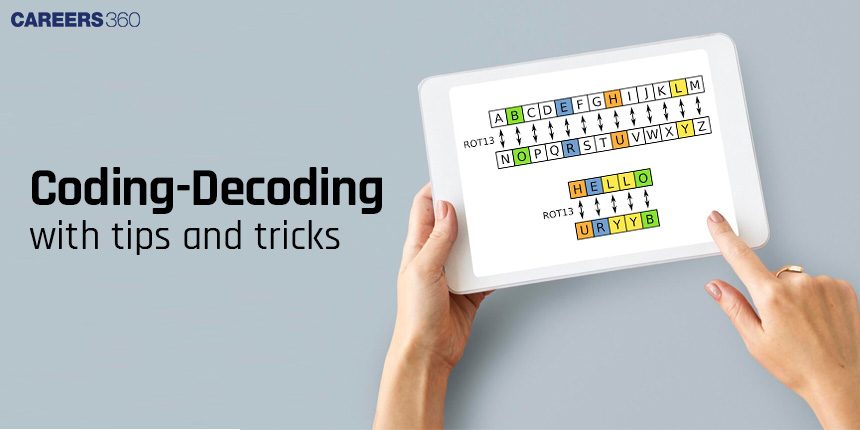
Types of Coding-Decoding
Following are the types of questions asked from the coding decoding reasoning -
Direct Letter coding
Deciphering message word codes
Deciphering number and symbol codes for messages
Deciphering number and letter codes for messages
Substitution based coding-decoding
Chinese coding
Jumbled coding
Conditional matrix
Let’s understand the types of coding decoding reasoning and coding decoding reasoning formula in detail with the help of examples -
1. Direct Letter Coding
In this type of coding, the letters are directly coded as letters with the help of different operations on the place value of the letters, such as addition, subtraction, etc. Let’s understand this with the help of an example.
Example: In a certain code language, MEDIUM is coded as LDCGSK. What is the code for PREFER in that code language?
Solution: Subtract 1 from the place values of the first three letters and subtract 3 from the place values of the last three letters of MEDIUM to obtain the required code.
MEDIUM→M – 1 = L; E – 1 = D; D – 1 = C; I – 2 = G; U – 2 = S; M – 2 = K
So, MEDIUM is coded as LDCGSK.
Similarly, for PREFER→P – 1 = O; R – 1 = Q; E – 1 = D; F – 2 = D; E – 2 = C; R – 2 = P
So, PREFER is coded as OQDDCP.
2. Deciphering Message Word Codes
In this type of coding, the letters of the given words are coded as letters with the help of different operations on the place value of the letters, such as addition, subtraction, etc. The position of letters is also shuffled to get the required code. Let’s understand this with the help of an example.
Example: In a certain code language, BELOW is coded as ASPIF. What is the code for BLOOD in that code language?
Solution: Add 4 to the place value of each letter of BELOW and then shuffle the position of the letters as shown below to get the required code.
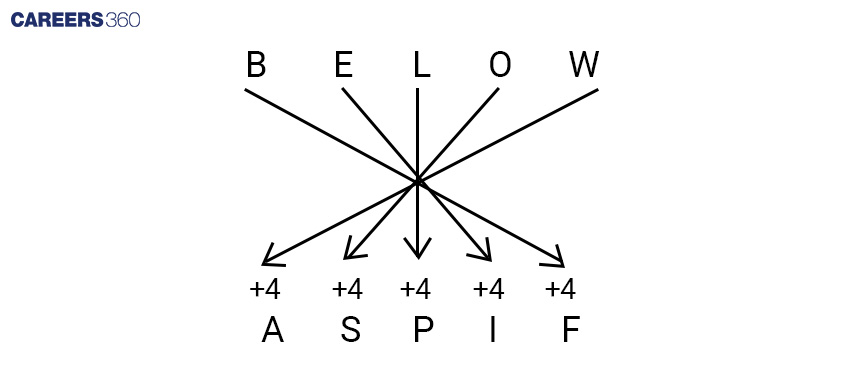
Thus, BELOW is coded as ASPIF.
Similarly, follow the same pattern for BLOOD –
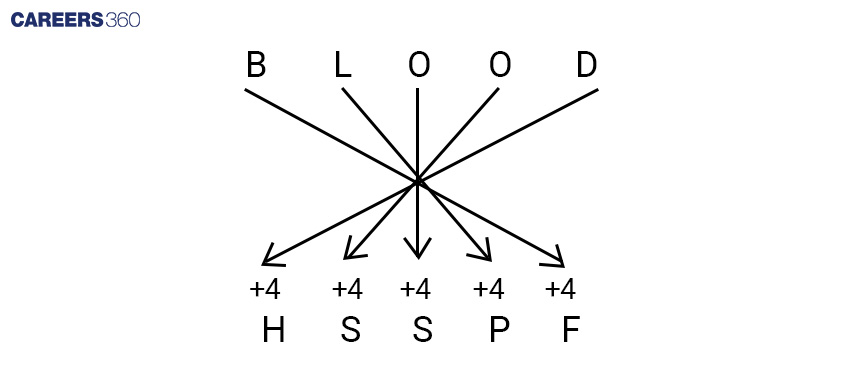
So, BLOOD is coded as HSSPF.
3. Deciphering Number and Symbol Codes for Messages
In this type of coding, the letters of the given words are coded as symbols or numbers following a particular pattern. Let’s understand this with the help of an example.
Example: If PENCIL is coded as ?@.=;7 and PAPER is coded as ?9?@5, how will you code CLIP?
Solution: Each letter of the word PENCIL is coded with the equivalent symbols and numbers given in the code –
P→?, E→@, N→., C→=, I→;, L→7
Thus, PENCIL is coded as ?@.=;7.
And, PAPER is coded as ?9?@ 5 –
P→?, A→9, P→?, E→@, R→5
All the letters of CLIP are given in PENCIL, therefore, the code for CLIP is→
C →=, L→7, I→;, P→?
So, CLIP is coded as =7;?.
4. Deciphering Number and Letter Codes for Messages
In this type of coding, the letters of the given words are coded as letters or numbers with the help of different operations on the place value of the letters, such as addition, subtraction, etc. Let’s understand this with the help of an example.
Example: In a certain code language, REPLACE is coded as 60. How will CRACKED be coded in that language?
Add the positional values of the letters of the given word REPLACE to obtain the required code –
R→18; E→5; P→16; L→12; A→1; C→3; E→5
Now, add the positional values of the given word REPLACE –
18 + 5 + 16 + 12 + 1 + 3 + 5 = 60
Thus, REPLACE is coded as 60.
Similarly, follow the same pattern for CRACKED –
C→3; R→18; A→1; C→3; K→11; E→5; D→4
Now, add the positional values of the given word CRACKED –
3 + 18 + 1 + 3 + 11 + 5 + 4 = 45
So, CRACKED is coded as 45.
5. Substitution-Based Coding-Decoding
In this type of coding, a word is coded with another word. Let’s understand this with the help of an example.
Example: If Blue means Pink, Pink means Green, Green means Yellow, Yellow means Red and Red means White, then what is the colour of turmeric?
Solution: As we know, in the real world, the colour of turmeric is yellow.
Therefore, according to the colour code, the colour of turmeric will be Red.
The candidates who are preparing for the upcoming entrance and Government exams can also refer to the links given below and master the reasoning ability section:
6. Chinese Coding
In this type of coding, a set of a few statements consisting of the same words, numbers, letters, or symbols in different order are coded as words, symbols, letters, or numbers. We have to find the codes of the given words in the statement by identifying the common words in different statements. The code for the common words will be the same in all the statements. Let’s understand this with the help of an example.
Example: In a code language, sky is blue is written as mud pot sum, I like blue is written as mud man log, and I am sky is written as man red pot. What is the code for the word ‘is’ in this language?
Solution:
Given:
1. sky is blue ⇒ mud pot sum
2. I like blue ⇒ mud man log
3. I am sky ⇒ man red pot
By comparing all the coded sentences, we find that –
In sentences 1 and 2, blue is a common word and mud is a common code.
In sentences 1 and 3, sky is a common word and pot is a common code.
In sentences 2 and 3, I is a common word and man is a common code.
The remaining words and codes in sentence 1 are is and sum; in sentence 2 are like and log; in sentence 3 are am and red.
Finally, blue ⇒ mud; sky ⇒ pot; I ⇒ man; is ⇒ sum; like ⇒ log; am ⇒ red. So, is will be coded as sum.
7. Jumbled Coding
In this type of coding, the position of the letters of the given word or letter cluster is shuffled in a particular pattern to get the coded word or letter cluster. Let’s understand this with the help of an example.
Example: In a certain code language, CROWNED is written as OWRCEND. How will SERGENT be written in that language?
Rearrange the position of the letters of CROWNED to get the required code.
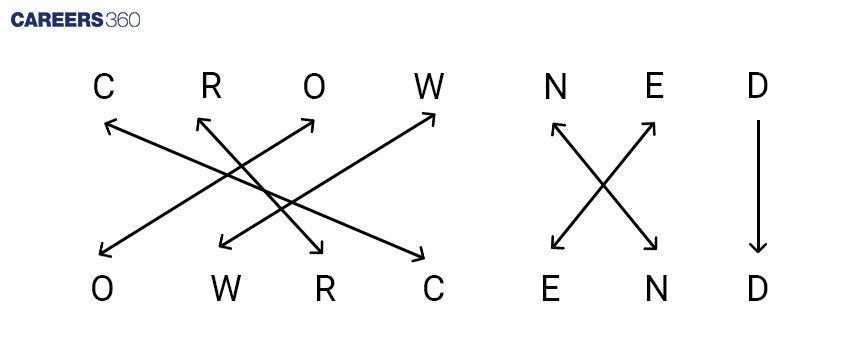
Thus, CROWNED is coded as OWRCEND. Similarly, follow the same pattern for SERGENT –
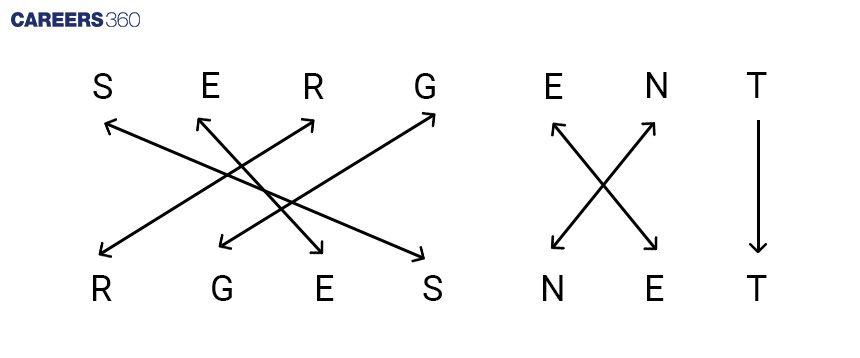
So, SERGENT is coded as RGESNET.
8. Conditional Matrix
This type of coding is based on the matrices. In this type of coding, two matrices are given in the question. In the given matrices, the letters are coded as certain numbers. One letter can have more than one code. Let’s understand this with the help of an example.
Example: A word is represented by only one set of numbers as given in any one of the alternatives. The sets of numbers given in the alternatives are represented by two classes of alphabets as in the two matrices, given below. The columns and rows of Matrix (I) are numbered from 0 to 4 and that of Matrix (II) are numbered from 5 to 9. A letter from these matrices can be represented first by its row and next by its column, e.g. A can be represented by 03,10, etc., and P can be represented by 55, 67, etc. Similarly, you have to identify the set for the word REST
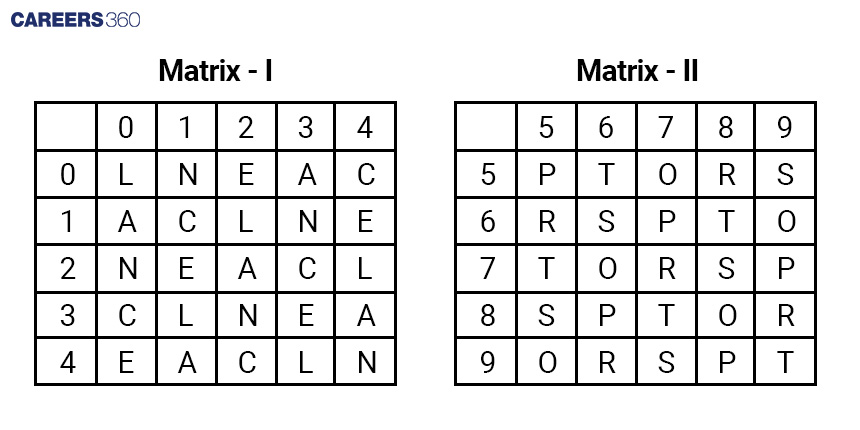
A) 96, 33, 44, 87
B) 58, 21, 85, 75
C) 89, 40, 31, 56
D) 77, 10, 5, 68
Here, from the matrices (Matrix 1 and Matrix 2) we get the numbers that represent the letters of the word REST –
R→58, 65, 77, 89, 96
E→02, 14, 21, 33, 40
S→59, 66, 78, 85, 97
T→56, 68, 75, 87, 99
Therefore, on comparing these numbers with the given alternatives, we get that the word REST is represented by the numbers 58, 21, 85, and 75. Hence, the second option is correct.
Recommended Books and Online Resources
1. A Modern Approach to Verbal & Non-Verbal Reasoning by R.S. Aggarwal
2. SSC Reasoning by Rakesh Yadav
3. The candidates must practice coding decoding reasoning MCQs, coding decoding reasoning practice set and coding decoding reasoning questions pdf to ace the topic coding decoding reasoning.
Question Weightage of Coding Decoding Reasoning Questions in Competitive Exams
The number of questions based on coding-decoding varies from exam to exam -
1) Questions asked in SSC exams i.e. SSC MTS, SSC CGL, SSC CHSL, SSC CPO, Steno - 4 to 5 questions.
2) Questions asked in the Railways exam i.e. Group D, NTPC, JE, ALP etc - 2 to 3 questions.
3) Questions asked in Banking exams, Bank PO, Bank Clerk - 3 to 4 questions.
4) Questions asked in the CUET exam - 2 to 3 questions.
Practice Questions For Direct Letter Coding
Q1. Directions: In a certain code language, AWAKED is coded as FPFDJW. What is the code for FACEUP in that code language?
A) KTHYZI
B) KTHXZI (Correct)
C) KTHZXI
D) TKHXZI
Solution:
Given:
AWAKED is coded as FPFDJW.
Add 5 and subtract 7 alternately from the place value of the letters of AWAKED to obtain the required code –
A + 5 = F; W – 7 = P; A + 5 = F; K – 7 = D; E + 5 = J; D – 7 = W
Thus, AWAKED is coded as FPFDJW.
Similarly, follow the same pattern for FACEUP –
F + 5 = K; A – 7 = T; C + 5 = H; E – 7 = X; U + 5 = Z; P – 7 = I
So, FACEUP is coded as KTHXZI. Hence, the second option is correct.
Q2. Directions: In a certain code language, MAZZA is written as OBBAC and BLACK is written as DMCDM. How will FUZZY be written in that language?
A) HVBAA (Correct)
B) HVBZA
C) HVBBA
D) HTBAA
Solution:
Given:
MAZZA is written as OBBAC and BLACK is written as DMCDM.
Add 2 and 1 alternately to the place value of the letters of MAZZA and BLACK to obtain the required code –
M + 2 = O; A + 1 = B; Z + 2 = B; Z + 1 = A; A + 2 = C
Thus, MAZZA is coded as OBBAC.
B + 2 = D; L + 1 = M; A + 2 = C; C + 1 = D; K + 2 = M
Thus, BLACK is coded as DMCDM.
Similarly, follow the same pattern for FUZZY –
F + 2 = H; U + 1 = V; Z + 2 = B; Z + 1 = A; Y + 2 = A
So, FUZZY is coded as HVBAA. Hence, the first option is correct.
Q3. Directions: In a code language, WINNER is written as XJOOFS. How will CARTOON be written in that language?
A) DBSOPPU
B) CAPTOON
C) DBSUPPO (Correct)
D) CAPNOOT
Solution:
Given:
WINNER is written as XJOOFS.
Add 1 to each letter of WINNER, to obtain the required code –
W + 1 = X; I + 1 = J; N + 1 = O; N + 1 = O; E + 1 = F; R + 1 = S
Thus, WINNER is coded as XJOOFS.
Similarly, follow the same pattern for CARTOON –
C + 1 = D; A + 1 = B; R + 1 = S; T + 1 = U; O + 1 = P; O + 1 = P; N + 1 = O
So, CARTOON is coded as DBSUPPO. Hence, the third option is correct.
Q4. Directions: In a certain code language, COURT is written as ERWUV and DANCE is written as FDPFG. How will EARTH be written in that language?
A) GDTWJ (Correct)
B) GDTWK
C) GDTVJ
D) GDTXJ
Solution:
Given:
COURT is written as ERWUV and DANCE is written as FDPFG.
Add 2 and 3 alternately to the place value of the letters of COURT and DANCE to obtain the required code –
C + 2 = E; O + 3 = R; U + 2 = W; R + 3 = U; T + 2 = V
Thus, COURT is coded as ERWUV.
D + 2 = F; A + 3 = D; N + 2 = P; C + 3 = F; E + 2 = G
Thus, DANCE is coded as FDPFG.
Similarly, follow the same pattern for EARTH –
E + 2 = G; A + 3 = D; R + 2 = T; T + 3 = W; H + 2 = J
So, EARTH is coded as GDTWJ. Hence, the first option is correct.
Q5. Directions: In a code language, TRUCKS is written as GIFXPH and WASTE is written as DZHGV. How will FANTASY be written in that language?
A) UZGMZHB
B) UZMGZHB (Correct)
C) UZMGHZB
D) UZMZGHB
Solution:
Given:
TRUCKS is written as GIFXPH and WASTE is written as DZHGV.
Determine the opposite letter pairs of the letters of TRUCKS and WASTE to get the required codes.
T→G; R→I; U→F; C→X; K→P; S→H
Thus, TRUCKS is coded as GIFXPH.
W→D; A→Z; S→H; T→G; E→V
Thus, WASTE is coded as DZHGV.
Similarly, follow the same pattern for FANTASY –
F→U; A→Z; N→M; T→G; A→Z; S→H; Y→B
So, FANTASY is coded as UZMGZHB. Hence, the second option is correct.
Practice Questions For Deciphering Message Word Codes
Q1. Directions: In a certain code language, SHOWER is coded as SEXOIS. What is the code for TOPICS in that code language?
A) TDJJPT
B) TCJJPT
C) TCJPPT (Correct)
D) TDJPPT
Solution:
Given:
SHOWER is coded as SEXOIS.
Add 1 to the place value of the second, fourth and sixth letters of the word SHOWER and the remaining letters will be the same. Then, reverse the order of the letters to get the required code.
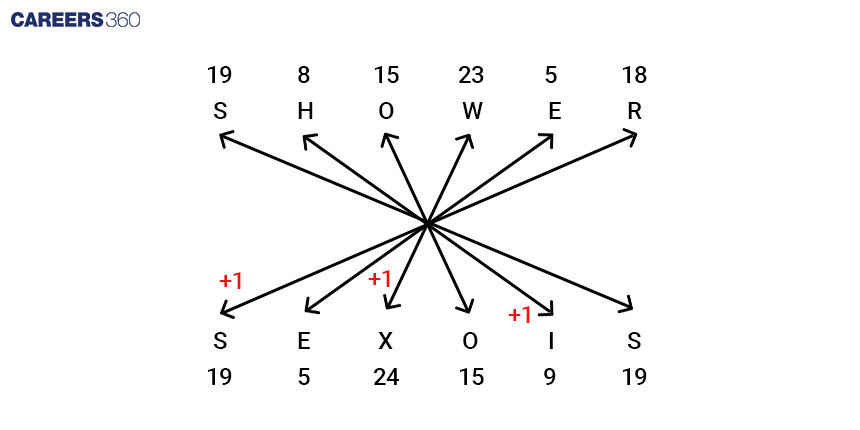
So, SHOWER is coded as SEXOIS.
Similarly, follow the same pattern for TOPICS –
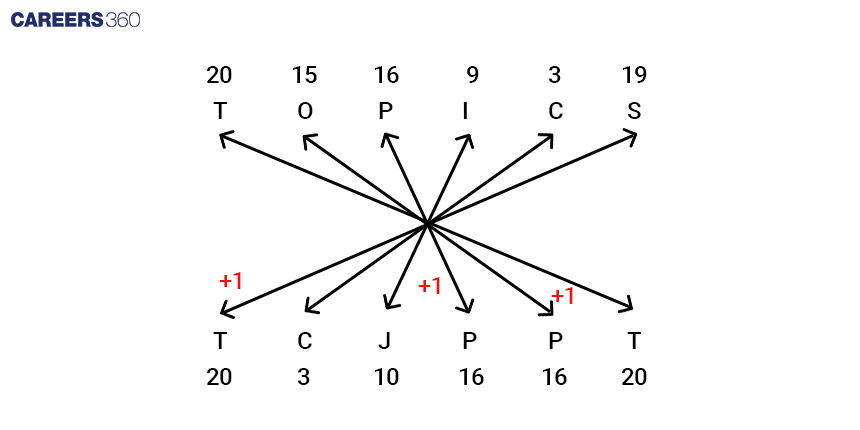
So, TOPICS is coded as TCJPPT. Hence, the third option is correct.
Q2. Directions: In a certain code language, FRIDAY is written as KTHACF, and MOSTLY is written as UQOANV. How will GINGER be written in that language?
A) PKITFI
B) TGIOKI
C) PKITGI (Correct)
D) PKIUHJ
Solution:
Given:
FRIDAY is written as KTHACF and MOSTLY is written as UQOANV.
Add 2 to the place of each letter of FRIDAY, and MOSTLY and then shuffle the position of the letters as shown below to get the required codes.
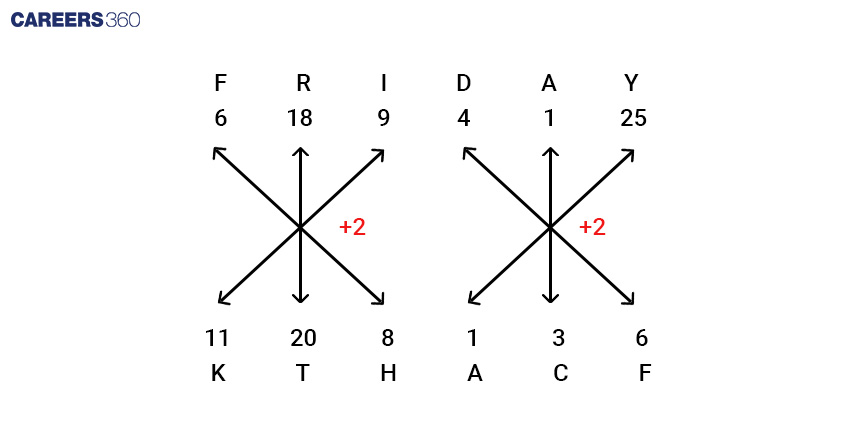
Thus, FRIDAY is coded as KTHACF.
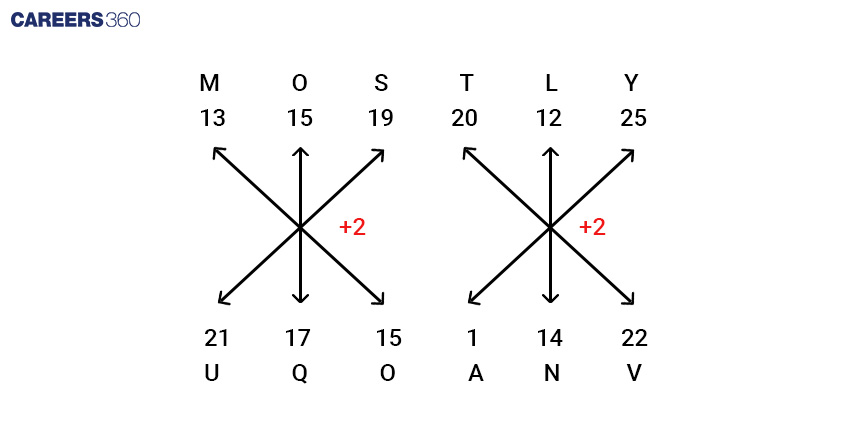
Thus, MOSTLY is coded as UQOANV.
Similarly, follow the same pattern for GINGER -
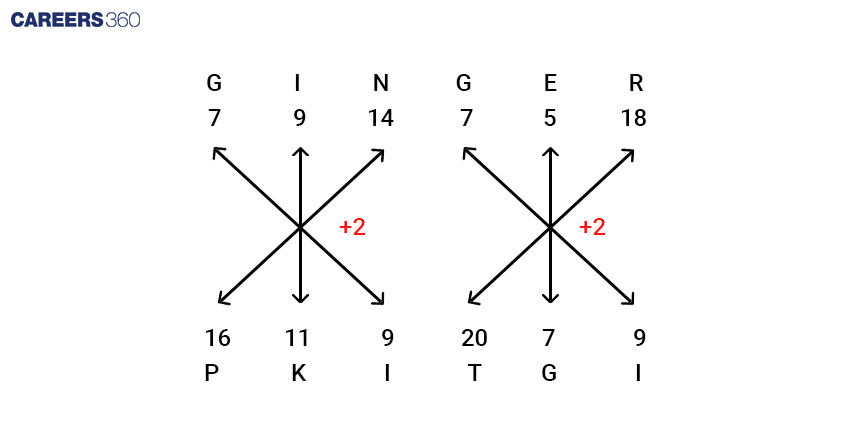
So, GINGER is coded as PKITGI. Hence, the third option is correct.
Q3. Directions: In a certain code language, CLOUDS is written as SBQAJM, and BRIGHT is written as EFRZPG. How will DREAMY be written in that language?
A) YKWCBP
B) YKWBPC (Correct)
C) YKXCPB
D) WKXBPC
Solution:
Given:
CLOUDS is written as SBQAJM and BRIGHT is written as EFRZPG.
Subtract 2 from the place value of each letter of CLOUDS and BRIGHT and shuffle their position as shown below to get the required codes.
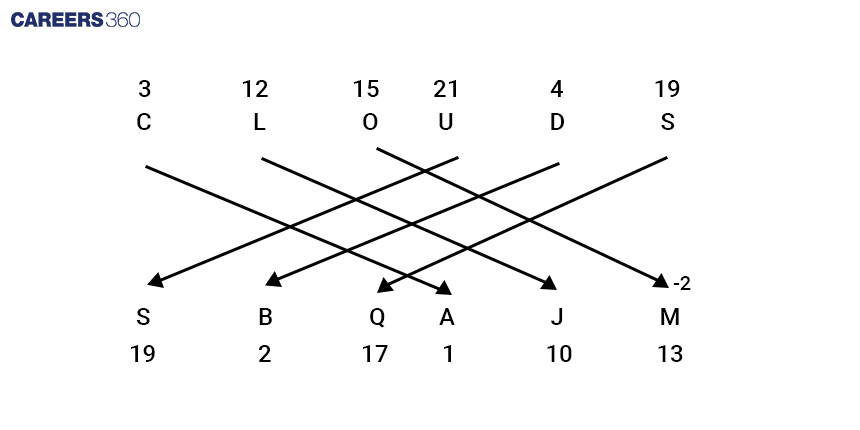
So, CLOUDS is written as SBQAJM.
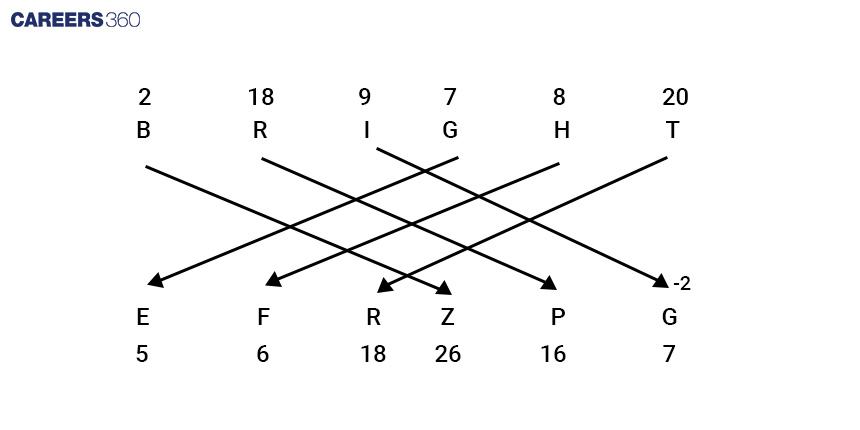
So, BRIGHT is written as EFRZPG.
Similarly, follow the same pattern for DREAMY –
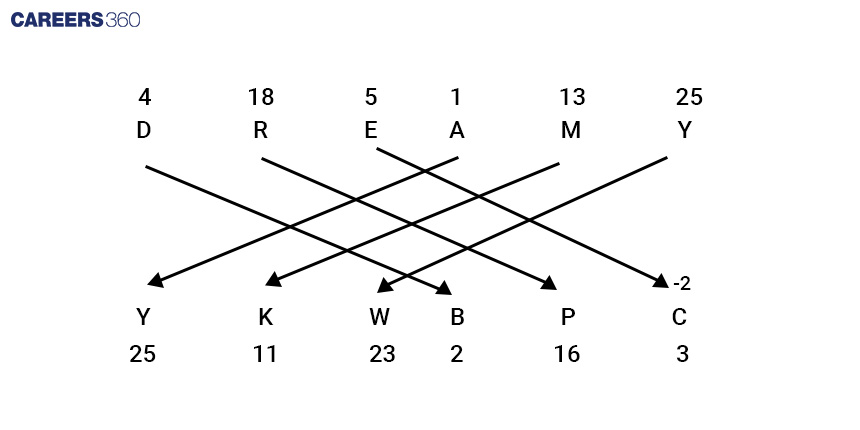
So, DREAMY is written as YKWBPC. Hence, the second option is correct.
Q4. Directions: In a certain code language, GARDEN is written as OFESBH. How will HANDLE be written in that language?
A) FMDOBI
B) FMEOBI (Correct)
C) FMGOBI
D) FMFOBI
Solution:
Given:
GARDEN is written as OFESBH.
Add 1 to the place value of each letter of GARDEN and then reverse the order of the letters to get the required code.
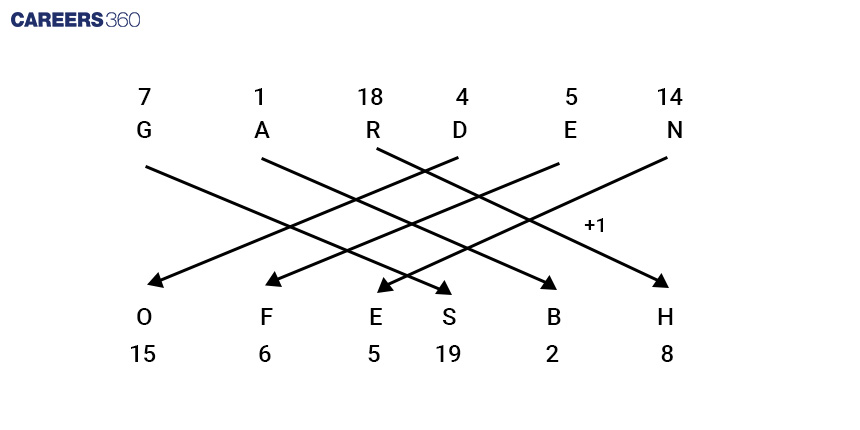
So, GARDEN is written as OFESBH.
Similarly, follow the same pattern for HANDLE –
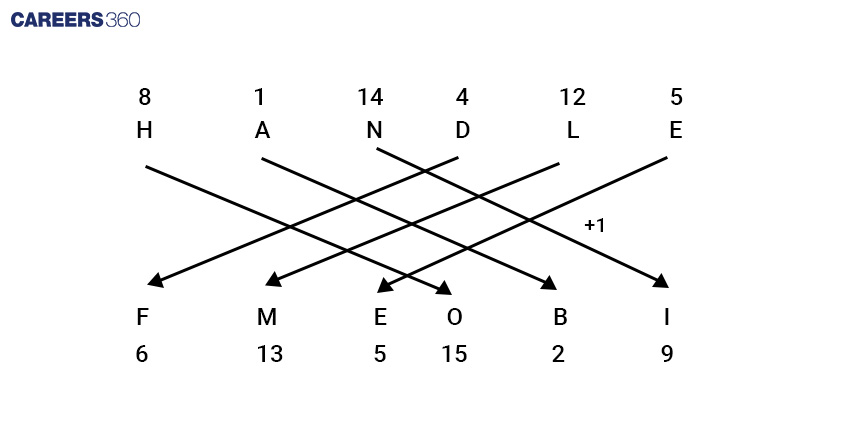
So, HANDLE is written as FMEOBI. Hence, the second option is correct.
Q5. Directions: In a certain code language, CHART is written as GDASS. How will INDEX be written in that language?
A) MIDWF
B) MJDWF (Correct)
C) MDJWF
D) MWDJF
Solution:
Given:
CHART is written as GDASS.
Add and subtract 1 from the place value of the letters of CHART and the middle letter of the word will remain the same then shuffle the position of the letters as shown below to get the required code.
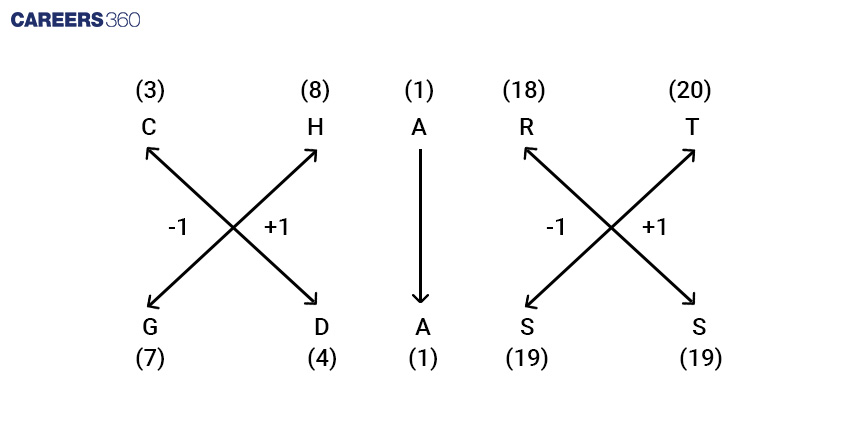
So, CHART is written as GDASS.
Similarly, follow the same pattern for INDEX –
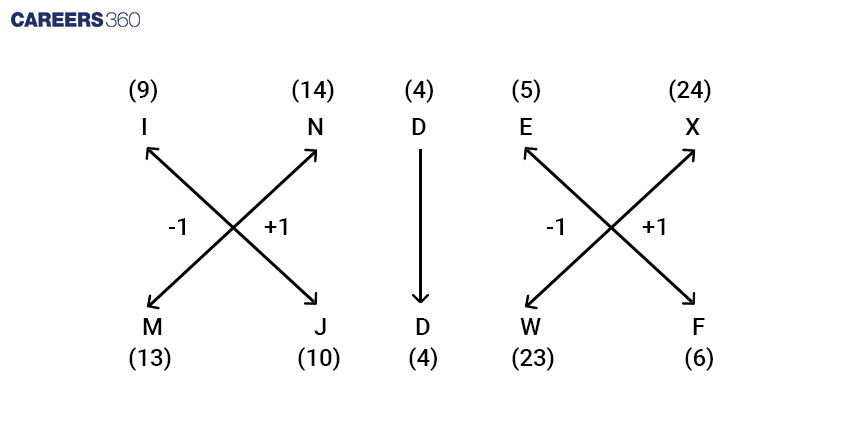
So, INDEX is written as MJDWF. Hence, the second option is correct.
Practice Questions For Deciphering Number and Symbol codes for messages
Q1. Directions: If WING is written as *£?= and THEN as @$ ©? then how will NITE be written?
A) ?*@©
B) ?£@© (Correct)
C) ?£$©
D) ?£@$
Solution:
Given:
WING is written as *£?= and THEN as @©©?Eachletterofthewordisassignedanindividualcode.W→∗,I→£,N→?,G→=,T→@,H→, E→©
So, as per the above codes, NITE is coded as ?£@©. Hence, the second option is correct.
Q2. Directions: Given below are a number in the first line and symbols in the second line. Numbers and symbols are code for each other. Choose the correct code for the given symbols.

Which number can be decoded from the following:

A) 58637 (Correct)
B) 56873
C) 57863
D) 58367
Solution:
Given:

In the given information each symbol represents the respective numbers.

Thus by decoding the symbols, we will get the respective numbers 58637. Hence the first option is correct.
Q3. Directions: Given below are the numbers in the first line and symbols in the second line. Numbers and symbols are codes for each other. Choose the correct code for the given symbols.

Which number can be decoded from the following:

A) 91486 (Correct)
B) 91846
C) 94816
D) 94846
Solution:
Given:

Now, code the symbols with their respective numbers given in the question –

Thus by decoding the symbols, we will get the respective number 91486. Hence the first option is correct.
Practice Questions For Deciphering number and letter codes for messages
Q1. Directions: In a certain code language, IMAGE is written as RN1TV. How will KNIFE be written in that language?
A) PIMVU
B) P9MUV
C) PM9UV (Correct)
D) PM9VU
Solution:
Given:
IMAGE is coded as RN1TV.
Write the place value of the middle letter and the opposite letters of the remaining letters of IMAGE to get the required codes.

So, IMAGE is coded as RN1TV.
Similarly, follow the same pattern for KNIFE –

So, KNIFE is coded as PM9UV. Hence, the third option is correct.
Q2. Directions: In a certain code language, ABCDE is coded as 45. What will be the code for XYZ in the given code language?
A) 215
B) 239
C) 219
D) 225 (Correct)
Solution:
Given:
ABCDE is coded as 45.
Multiply the sum of the place values of the letters of ABCDE by 3 to get the required code.
A→1; B→2; C→3; D→4; E→5
Add all the place values to get the sum→1 + 2 + 3+ 4 + 5 = 15
Now, multiply the sum by 3→15 * 3 = 45
Thus, ABCDE is coded as 45.
Similarly, follow the same pattern for XYZ; X→24; Y→25; Z→26
Add all the place values to get the sum→24 + 25 + 26 = 75
Now, multiply the sum by 3→75 * 3 = 225
So, XYZ is coded as 225. Hence, the fourth option is correct.
Q3. Directions: In a certain code language, QUEZAL is coded as 82. What is the code for ADVERSE in the given code language?
A) 68
B) 78
C) 74 (Correct)
D) 82
Solution:
Given:
QUEZAL is coded as 82.
Add the place value of the letters of QUEZAL to get the required code.
Place value of the letters – Q = 17; U = 21; E = 5; Z = 26; A = 1; L = 12
Now, add the positional values – 17 + 21 + 5 + 26 + 1 + 12 = 82
Thus, QUEZAL is coded as 72.
Similarly, follow the same pattern for ADVERSE –
Place value of the letters – A = 1; D = 4; V = 22; E = 5; R = 18; S = 19; E = 5
Now, add the positional values – 1 + 4 + 22 + 5 + 18 + 19 + 5 = 74
So, ADVERSE is coded as 74. Hence, the third option is correct.
Q4. Directions: In a certain code language, RHETORIC is coded as 6 and GURGLE is coded as 4. What will be the code for SIGNATURE in the given code language?
A) 5
B) 7 (Correct)
C) 8
D) 12
Solution:
Given:
RHETORIC is coded as 6 and GURGLE is coded as 4.
Subtract 2 from the total number of letters in the words RHETORIC and GURGLE to obtain the required code –
RHETORIC: 8 – 2 = 6
Thus, RHETORIC is coded as 6.
GURGLE: 6 – 2 = 4
Thus, GURGLE is coded as 4.
Similarly, follow the same pattern for SIGNATURE –
SIGNATURE: 9 – 2 = 7
Thus, SIGNATURE is coded as 7. Hence, the second option is correct.
Q5. Directions: In a certain code language, PACKET is coded as 62, POST is coded as 74, and FAIR is coded as 38. How is PEOPLE coded in the given language?
A) 72
B) 75 (Correct)
C) 80
D) 77
Solution:
Given:
PACKET is coded as 62, POST is coded as 74, and FAIR is coded as 38.
Add the number of letters with the positional values of PACKET to obtain the required code –
P (16) + A (1) + C (3) + K (11) + E (5) + T (20) + 6→16 + 1 + 3 + 11 + 5 + 20 + 6 = 62
Thus, PACKET is coded as 62.
And in, POST is coded as 74 –
P (16) + O (15) + S (19) + T (20) + 4→16 + 15 + 19 + 20 + 4 = 74
Thus, POST is coded as 74.
And in, FAIR is coded as 38 –
F (6) + A (1) + I (9) + R (18) + 4→6 + 1 + 9 + 18 + 4 = 38
Similarly, follow the same pattern for PEOPLE –
P (16) + E (5) + O (15) + P (16) + L (12) + E (5) + 6→16 + 5 + 15 + 16 + 12 + 5 + 6 = 75
So, the code for PEOPLE is 75. Hence, the second option is correct.
Practice Questions For Substitution-based coding-decoding
Q1. Directions: If air is called green, green is called blue, blue is called sky, sky is called yellow, yellow is called water, and water is called pink then what is the colour of a clear sky?
A) Sky
B) Water
C) Blue
D) Yellow (Correct)
Solution:
According to the given information –
air is called green
green is called blue
blue is called sky
sky is called yellow
yellow is called water
water is called pink
So, the colour of the sky is blue and would be called sky. Hence, the first option is correct.
Q2. Directions: If 0, 1, 2, 3,....., 9 is written as a, b, c, d, ....j, then find dc × f – (bf – d) × d.
A) bcf
B) abe
C) abb
D) bce (Correct)
Solution:
Given:
0, 1, 2, 3,....., 9 is written as a, b, c, d, ....j
dc × f – (bf – d) × d = ?
The equation is –
32 × 5 – (15 – 3) × 3
= 160 – 12 × 3 = 160 – 36 = 124→bce
So, after solving the equation the answer is bce. Hence, the fourth option is correct.
Practice Questions For Chinese Coding
Q1. Directions: In a certain code language, 629 is coded as namo te fek, 943 is coded as dump to te, and 748 is coded as to fir tako. What is the code for the letter 3 in that language?
A) dump (Correct)
B) to
C) fir
D) te
Solution:
Given:
1. 629 ⇒ namo te fek
2. 943 ⇒ dump to te
3. 748 ⇒ to fir tako
By comparing all the above-coded numbers, we find that –
In sentences 1 and 2, 9 and te are common.
In sentences 2 and 3, 4 and to are common.
The remaining number and the code in sentence 1 are 6/2 and namo/fek; in sentence 2 are 3 and dump; in sentence 3 are 7/8 and fir/tako.
Finally, 9 ⇒ te; 4 ⇒ to; 6/2 ⇒ namo/fek; 3 ⇒ dump
So, 3 will be coded as dump. Hence, the first option is correct.
Q2. Directions: In a code language, food is fresh is coded as dy in pq, bring fresh food is coded as tq pq dy, and food is hot is coded as dy in to. What is the code for the word fresh?
A) In
B) to
C) pq (Correct)
D) dy
Solution:
Given:
1. food is fresh ⇒ dy in pq
2. bring fresh food ⇒ tq pq dy
3. food is hot ⇒ dy in to
By comparing all the coded sentences, we find that –
In sentences 1 and 2, food and fresh are common words and pq and dy are common codes.
In sentences 1 and 3, food and is are common words and dy and in are common codes.
The remaining words and code are in sentence 2; bring and tq and in sentence 3; hot and to.
Finally, food ⇒ dy; fresh ⇒ pq; is ⇒ in; bring ⇒ tq; hot ⇒ to
So, fresh will be coded as pq. Hence, the third option is correct.
Q3. Directions: In a code language, you can start is written as sent room dark, can you read is written as room sent less, and you are good is written as tyre room spin. What is the code for the word can in this language?
A) room
B) sent (Correct)
C) spin
D) dark
Solution:
Given:
1. you can start ⇒ sent room dark
2. can you read ⇒ room sent less
3. you are good ⇒ tyre room spin
By comparing all the above-coded sentences, we find that –
In sentences 1 and 2, can is the common word and sent is the common code.
In sentences 1, 2 and 3, the common word is you and the common code is room.
The remaining words and codes in sentence 1 are start and dark; in sentence 2 read and less; in sentence 3 are/good and tyre/spin.
Finally, can ⇒ sent; you ⇒ room; start ⇒ room; read ⇒ less; are/good ⇒ tyre/spin
So, can will be coded as sent. Hence, the second option is correct.
Q4. Directions: In a code language, you are tall is coded as la da ma, you workout daily is coded as la pa ka, and daily workout makes you tall is coded as ka pa ja la ma. What is the code for the word makes?
A) ma
B) ja (Correct)
C) la
D) pa
Solution:
Given:
1. you are tall ⇒ la da ma
2. you workout daily ⇒ la pa ka
3. daily workout makes you tall ⇒ ka pa ja la ma
By comparing all the three coded sentences, we find that –
In sentences 1, 2, and 3, you and la are common.
In sentences 2 and 3, workout, daily and pa, ka are common.
In sentences 1 and 3, tall and ma are common.
The remaining words and code are in sentence 1; are and da; In sentence 3; makes and ja.
Finally, you ⇒ la; workout ⇒ pa/ka; daily ⇒ pa/ka; tall ⇒ ma; are ⇒ da; makes ⇒ ja.
So, makes is coded as ja. Hence, the second option is correct.
Q5. Directions: In a certain code language, Neha plays volleyball means no la ta. Neha likes playing means la to zu, volleyball is best game means xu no ba cu, then what is the code for Volleyball?
A) ta
B) ba
C) no (Correct)
D) la
Solution:
Given:
1. Neha plays Volleyball means no la ta
2. Neha likes playing means la to zu
3. Volleyball is best game means xu no ba cu
On comparing all the three coded sentences, we find that –
In sentences 1 and 2, Neha and la are common.
In sentences 1 and 3, Volleyball and no are common.
The remaining words and codes in sentence 1 are plays and ta; in sentence 2 are likes, playing and to, zu; in sentence 3 are is, best, game and xu, ba, cu.
So, the code for volleyball is no. Hence, the third option is correct.
Practice Questions For Jumbled Coding
Q1. Directions: In a certain code language, MOUNTAIN is written as MNIATNUO. How will BIRTHDAY be written in that language?
A) BYADHTRI (Correct)
B) BIYDHATR
C) YADHTRIB
D) YBIRHTDA
Solution:
Given:
MOUNTAIN is written as MNIATNUO and SENTENCE is written as SECNETNE.
The first letter of the given words will remain fixed at its position and reverse the order of the remaining letters. The pattern followed is as follows -
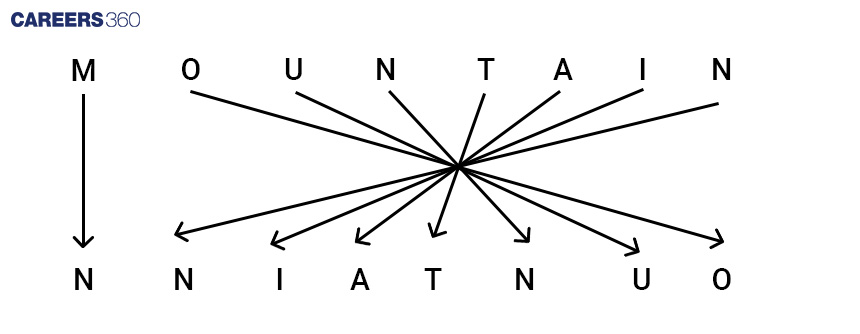
Thus, MOUNTAIN is coded as MNIATNUO.
Similarly, follow the same pattern for BIRTHDAY –
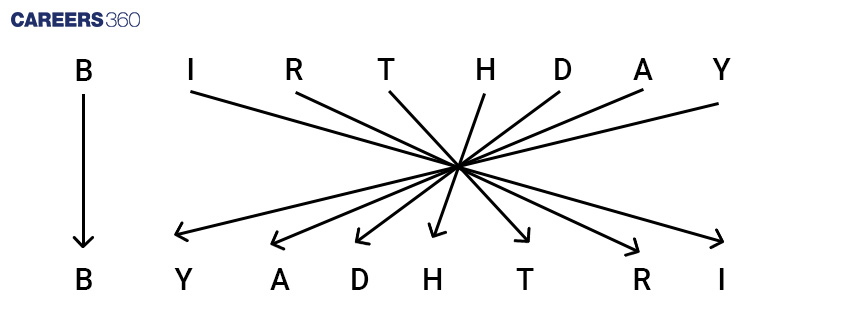
So, BIRTHDAY is coded as BYADHTRI. Hence, the first option is correct.
Q2. Directions: In a certain code language, ROBOT is written as BOTOR, and BRING is written as INGRB. How will PANTS be written in that language?
A) STNAP
B) NAPTS
C) NTSAP (Correct)
D) NTSPA
Solution:
Given:
ROBOT is written as BOTOR and BRING is written as INGRB.
Shuffle the position of the letters of the words ROBOT and BRING to get the required codes.

So, ROBOT is written as BOTOR.

So, BRING is written as INGRB.
Similarly, follow the same pattern for PANTS –

So, PANTS is written as NTSAP. Hence, the third option is correct.
Q3. Directions: In a certain code language, ABSENCE is written as ASBECNE. How will EXACTLY be written in that language?
A) EAXCLYT
B) EXACTLY
C) EAXTCLY
D) EAXCLTY (Correct)
Solution:
Given:
ABSENCE is written as ASBECNE.
Here, interchange the position of the second and third letters and the fifth and sixth letters. The remaining letters will remain in their position.
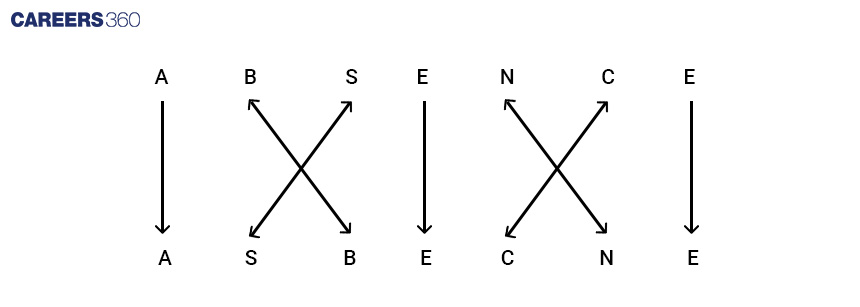
Thus, ABSENCE is written as ASBECNE.
Similarly, follow the same pattern for EXACTLY –
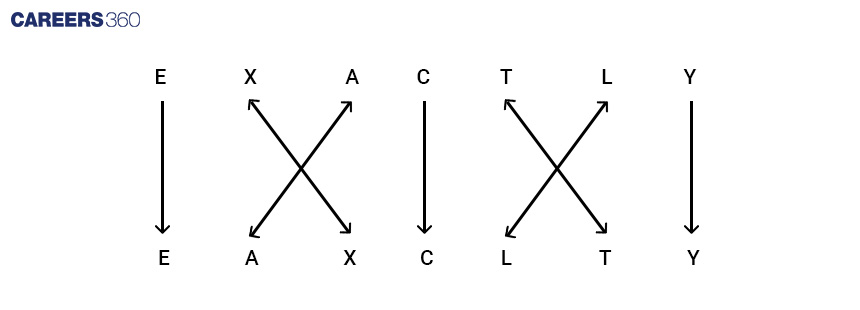
So, EXACTLY is written as EAXCLTY. Hence, the fourth option is correct.
Q4. Directions: In a certain code language, EXPORT is coded as ORTEXP. What is the code for GENTLE in that code language?
A) TLENEG
B) TELNEG
C) TLEGEN (Correct)
D) TLENGE
Solution:
Given:
EXPORT is coded as ORTEXP.
To obtain the code of a required word the last three letters are written first followed by the first three letters.
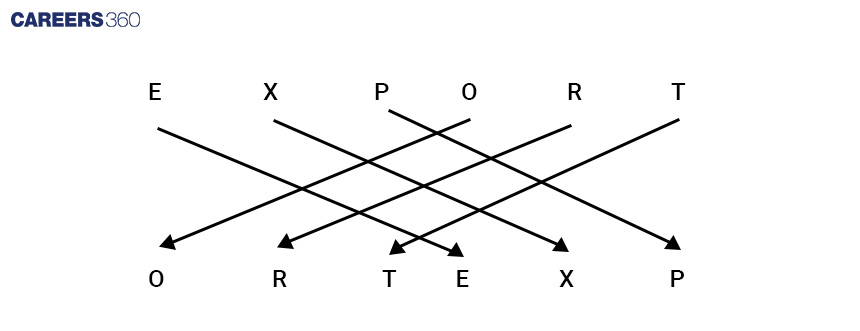
Thus, EXPORT is coded as ORTEXP.
Similarly, follow the same pattern for GENTLE –
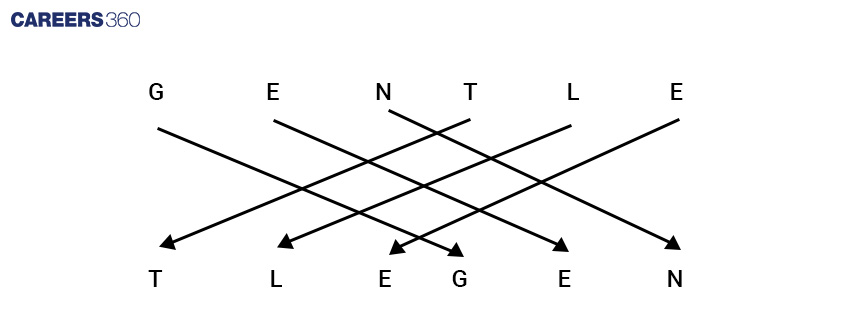
So, GENTLE is coded as TLEGEN. Hence, the third option is correct.
Q5. Directions: In a certain code language, PROVED is coded as VEDPRO. What is the code for ROBUST in that code language?
A) USTROB (Correct)
B) USTROC
C) VSTRBO
D) VSTROB
Solution:
Given:
PROVED is coded as VEDPRO.
To obtain the code of a required word the last three letters are written first followed by the first three letters.
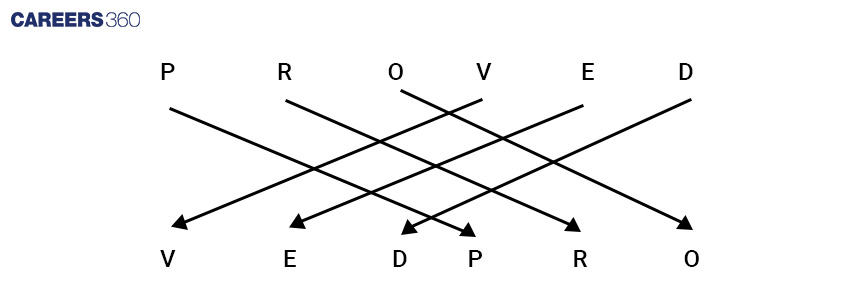
Thus, PROVED is coded as VEDPRO.
Similarly, follow the same pattern for ROBUST –
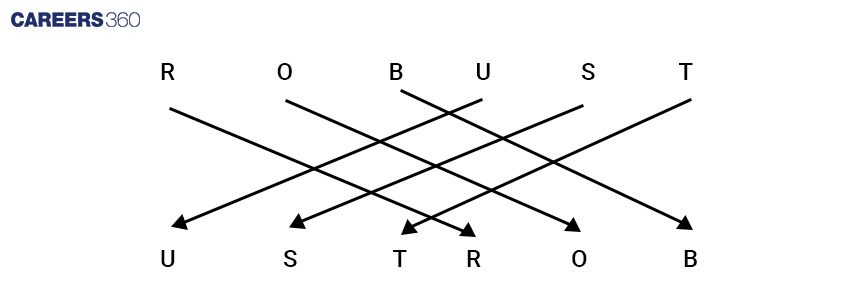
So, ROBUST is coded as USTROB. Hence, the first option is correct.
Practice Questions For Conditional Matrix
Q1. Directions: A word is represented by only one set of numbers as given in any one of the alternatives. The sets of numbers given in the alternatives are represented by two classes of alphabets as in the two matrices, given below. The columns and rows of Matrix (I) are numbered from 0 to 4 and that of Matrix (II) are numbered from 5 to 9. A letter from these matrices can be represented first by its row and next by its column, e.g. P can be represented by 55,69, etc, and L can be represented by 59, 68, etc. Similarly, you have to identify the set for the word, LAPSE.
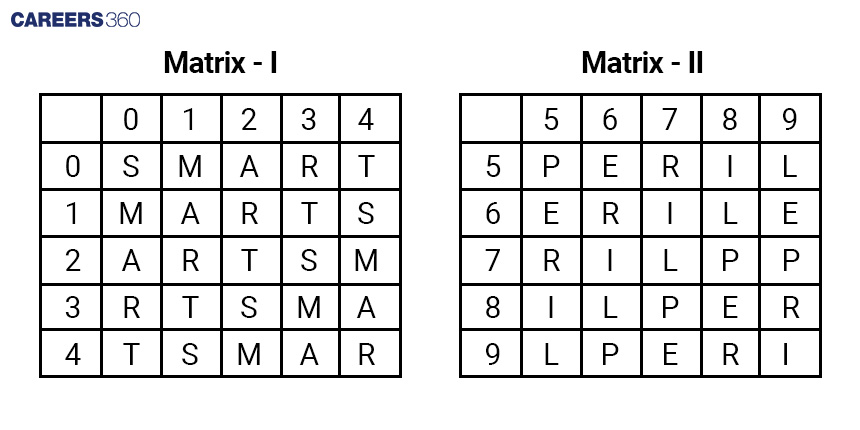
A) 86, 02, 55, 14, 97 (Correct)
B) 86, 57, 00, 41, 97
C) 31, 02, 00, 96, 42
D) 31, 57, 55, 41, 42
Solution:
Given:
LAPSE
Number representations of each letter –
L→59, 68, 77, 86, 95
A→02, 11, 20, 34, 43
P→55, 69, 78, 87, 96
S→00, 14, 23, 32, 41
E→56, 65, 79, 88, 97
Let's check the options –
First option: 86, 02, 55, 14, 97 – All the letters of the word LAPSE can be represented through this option.
Second option: 86, 57, 00, 41, 97 – A and P can not be represented as 57 and 00 respectively.
Third option: 31, 02, 00, 96, 42 – L, P, S, and E can not be represented as 31, 00, 96, and 42 respectively.
Fourth option: 31, 57, 55, 41, 42 – L, A, and E can not be represented as 31, 57, and 42 respectively.
So, only the first option consists of the numbers through which LAPSE can be represented. Hence, the first option is correct.
Q2. Directions: A word is represented by only one set of numbers as given in any one of the alternatives. The sets of numbers given in the alternatives are represented by two classes of alphabets as in the two matrices given below. The columns and rows of Matrix (I) are numbered from 0 to 4 and that of Matrix (II) are numbered from 5 to 9. A letter from these matrices can be represented first by its row and next by its column, e.g. C can be represented by 55, 69, etc., and D can be represented by 59, 68, etc. Similarly, you have to identify the set for the word CHILD.
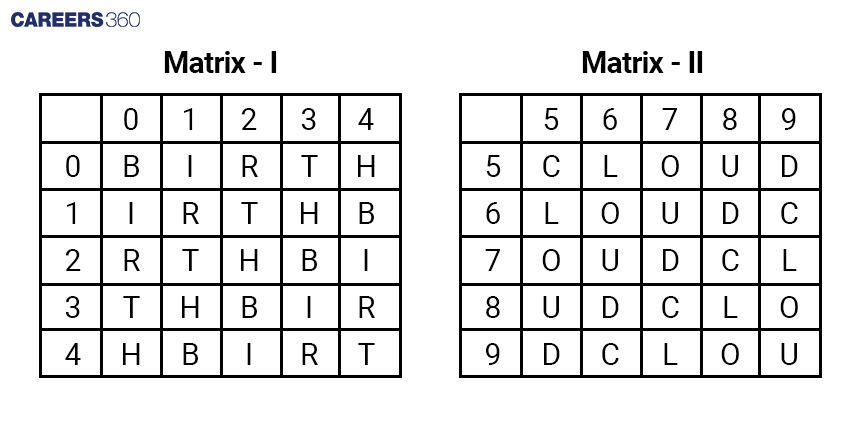
A) 55, 13, 42, 79, 68 (Correct)
B) 96, 22, 97, 24, 13
C) 96, 13, 42, 79, 13
D) 55, 22, 97, 24, 68
Solution:
Given:
CHILD
Number representations of each letter –
C→55, 69, 78, 87, 96
H→04, 13, 22, 31, 40
I→01, 10, 24, 33, 42
L→56, 65, 79, 88, 97
D→59, 68, 77, 86, 95
Let's check the options –
First option: 55, 13, 42, 79, 68 – All the letters of the word CHILD can be represented through this option.
Second option: 96, 22, 97, 24, 13 – I, L, and, D cannot be represented by 97, 24, and, 13 respectively.
Third option: 96, 13, 42, 79, 13 – D cannot be represented by 13.
Fourth option: 55, 22, 97, 24, 68 – I and L cannot be represented by 97 and 24 respectively.
So, only the first option consists of the numbers through which CHILD can be represented. Hence, the first option is correct.
Q3. Directions: A word is represented by only one set of numbers as given in any one of the alternatives. The sets of numbers given in the alternatives are represented by two classes of alphabets as in the two matrices, given below. The columns and rows of Matrix (I) are numbered from 0 to 4 and that of Matrix (II) are numbered from 5 to 9. A letter from these matrices can be represented first by its row and next by its column, e.g. P can be represented by 55, 69, etc, and L can be represented by 59, 68, etc. Similarly, you have to identify the set for the word PEST.
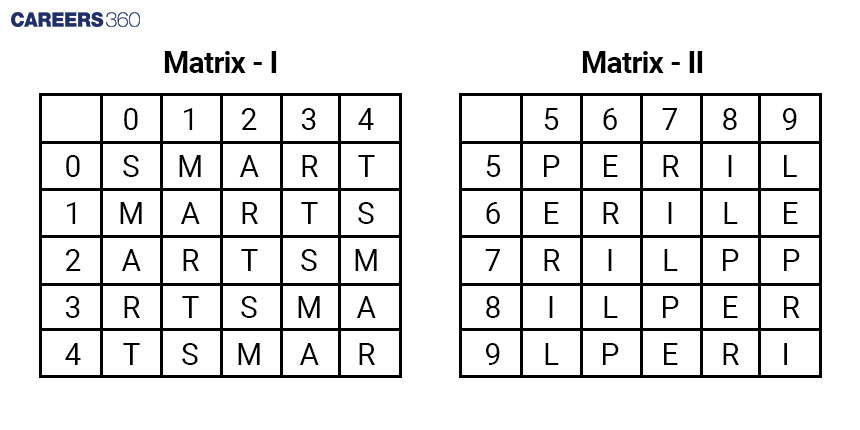
A) 87, 56, 03, 04
B) 55, 79, 23, 22 (Correct)
C) 69, 98, 41, 40
D) 96, 65, 32, 00
Solution:
Given:
PEST
Number representations of each letter –
P→55, 69, 78, 87, 96
E→56, 65, 79, 88, 97
S→00, 14, 23, 32, 41
T→04, 13, 22, 31, 40
Let's check the options –
First option: 87, 56, 03, 04 – S cannot be represented by 03.
Second option: 55, 79, 23, 22 – All the letters of the word PEST can be represented through this option.
Third option: 69, 98, 41, 40 – E cannot be represented as 98.
Fourth option: 96, 65, 32, 00 – T cannot be represented as 00.
So, only the second option consists of the numbers through which PEST can be represented. Hence, the second option is correct.
Q4. Directions: A word is represented by only one set of numbers as given in any one of the alternatives. The sets of numbers given in the alternatives are represented by two classes of alphabets as in the two matrices, given below. The columns and rows of Matrix (I) are numbered from 0 to 4 and that of Matrix (II) are numbered from 5 to 9. A letter from these matrices can be represented first by its row and next by its column, e.g. C can be represented by 55, 69, etc, and D can be represented by 59, 68, etc. Similarly, you have to identify the set for the word BLOW.
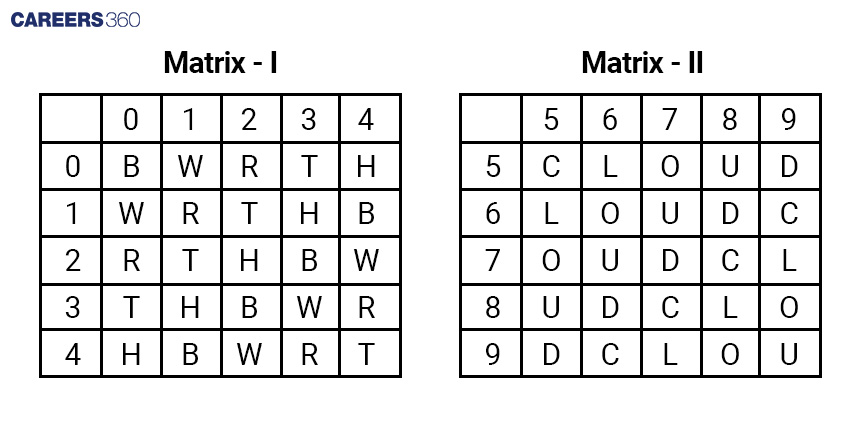
A) 14, 56, 89, 34
B) 00, 65, 67, 10
C) 41, 87, 57, 01
D) 32, 88, 98, 33 (Correct)
Solution:
Given:
BLOW
Number representations of each letter –
B→00, 14, 23, 32, 41
L→56, 65, 79, 88, 97
O→57, 66, 75, 89, 98
W→01, 10, 24, 33, 42
Let's check the options –
First option: 14, 56, 89, 34 – W cannot be represented by 34.
Second option: 00, 65, 67, 10 – O cannot be represented as 67.
Third option: 41, 87, 57, 01 – L cannot be represented as 87.
Fourth option: 32, 88, 98, 33 – All the letters of the word BLOW can be represented through this option.
So, only the fourth option consists of the numbers through which BLOW can be represented. Hence, the fourth option is correct.
Q5. Directions: A word is represented by only one set of numbers as given in any one of the alternatives. The sets of numbers given in the alternatives are represented by two classes of alphabets as in the two matrices, given below. The columns and rows of Matrix (I) are numbered from 0 to 4 and that of Matrix (II) are numbered from 5 to 9. A letter from these matrices can be represented first by its row and next by its column, e.g. A can be represented by 01, 20, etc, and B can be represented by 56, 65, etc. Similarly, you have to identify the set for the word, CARS.
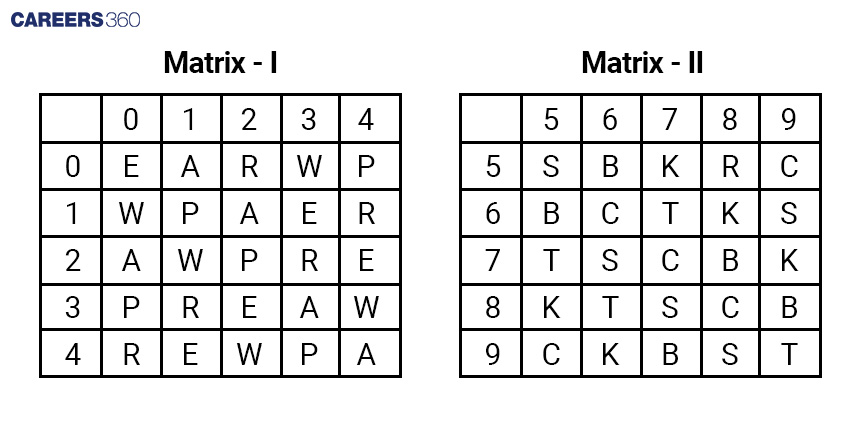
A) 66, 20, 31, 88
B) 77, 33, 40, 69 (Correct)
C) 96, 00, 23, 99
D) 95, 01, 13, 77
Solution:
Given:
CARS
Number representations of each letter –
C→59, 66, 77, 88, 95
A→20, 01, 12, 33, 44
R→40, 31, 02, 23, 14
S→55, 76, 87, 98, 69
Let's check the options –
First option: 66, 20, 31, 88 – S cannot be represented by 88.
Second option: 77, 33, 40, 69 – All the letters of the word CARS can be represented through this option
Third option: 96, 00, 23, 99 – C, A, and S cannot be represented as 96, 00, and 99 respectively.
Fourth option: 95, 01, 13, 77 – R and S cannot be represented as 13 and 77 respectively.
So, only the second option consists of the numbers through which CARS can be represented. Hence, the second option is correct.
Note: The coding decoding reasoning practice questions for entrance and competitive exams such as coding decoding questions for bank PO, coding decoding questions for college entrance exams are given below for your reference.
Coding-Decoding Questions for SRMJEE/ VITEEE/ CUET
Q-1) Directions: In a certain code language, MAZZA is written as OBBAC and BLACK is written as DMCDM. How will FUZZY be written in that language?
1) HVBAA
2) HVBZA
3) HVBBA
4) HTBAA
Solution:
Add 2 and 1 alternately to the place value of the letters of MAZZA to obtain the required code –
M + 2 = O; A + 1 = B; Z + 2 = B; Z + 1 = A; A + 2 = C
Thus, MAZZA is coded as OBBAC.
And, BLACK is written as DMCDM –
B + 2 = D; L + 1 = M; A + 2 = C; C + 1 = D; K + 2 = M
Similarly, follow the same pattern for FUZZY –
F + 2 = H; U + 1 = V; Z + 2 = B; Z + 1 = A; Y + 2 = A
So, FUZZY is coded as HVBAA. Hence, the first option is correct.
Q-2) Directions: If in a certain code language, BASE is coded as 27, then what is the code of COLLECTION in the same coded language?
1) 107
2) 111
3) 108
4) 110
Solution:
Add the position value of the letters of the word BASE, to obtain the required code –
B→2; A→1; S→19; E→5
Now, add the position values –
2 + 1 + 19 + 5 = 27
Thus, BASE is coded as 27.
Similarly, follow the same pattern for COLLECTION –
C→3; O→15; L→12; L→12; E→5; C→3; T→20; I→9; O→15; N→14
Now, add the position values –
3 + 15 + 12 + 12 + 5 + 3 + 20 + 9 + 15 + 14 = 108
Thus, COLLECTION is coded as 108. Hence, the third option is correct.
Q-3) Directions: In a certain code language, JAIL is coded as 304, and LAWN is coded as 232. What is the code for NAVY in that code language?
1) 312
2) 184
3) 188
4) 182
Solution:
Add the reverse position value of the letters of the word JAIL and multiply the resultant with the total number of letters, to obtain the required code –
J→17; A→26; I→18; L→15
Now, add the reverse position values and multiply the resultant with the total number of letters –
17 + 26 + 18 + 15 = 76 × 4 = 304
Thus, JAIL is coded as 304.
And, LAWN is coded as 232.
L→15; A→26; W→4; N→13
Now, add the reverse position values and multiply the resultant with the total number of letters –
15 + 26 + 4 + 13 = 58 × 4 = 232
Thus, LAWN is coded as 232.
Similarly, follow the same pattern for NAVY –
N→13; A→26; V→5; Y→2
Now, add the reverse position values and multiply the resultant with the total number of letters –
13 + 26 + 5 + 2 = 46 × 4 = 184
So, NAVY is coded as 184. Hence, the second option is correct.
Coding-Decoding Questions for APICET/ KMAT
Q-1) Directions: 9 is related to 80 following a certain logic. Following the same logic, 17 is related to 288. To which of the following is 23 related, following the same logic?
1) 527
2) 525
3) 526
4) 528
Solution:
Given:
9 is related to 80 and 17 is related to 288.
Subtract 1 from the square of the first number to obtain the code –
Like, 9 is related to 80→92 – 1 = 81 – 1 = 80
And, 17 is related to 288→172 – 1 = 289 – 1 = 288
Similarly, for 23→232 – 1 = 529 – 1 = 528
So, 23 is related to 528. Hence, the fourth option is correct.
Q-2) Directions: LOQR is related to GJLM in a certain way based on the English alphabetical order. In the same way, SVXY is related to NQST. To which of the following is NQST related, following the same logic?
1) INMO
2) IMOQ
3) ILNO
4) IMNO
Solution:
Given:
LOQR is related to GJLM and SVXY is related to NQST.
Subtract 5 from the place value of LOQR to obtain the required code –
L – 5 = G; O – 5 = J; Q – 5 = L; R – 5 = M
Thus, LOQR is related to GJLM.
And, SVXY is related to NQST –
S – 5 = N; V – 5 = Q; X – 5 = S; Y – 5 = T
Thus, SVXY is related to NQST.
Similarly, follow the same pattern for NQST –
N – 5 = I; Q – 5 = L; S – 5 = N; T – 5 = O
Thus, NQST is related to ILNO. Hence, the third option is correct.
Q-3) Directions: In a certain code language, door grill windows wood clothes are coded as kip dip lip sip tip, table wood chair stools are coded as rip nip dip pip, chair grill stools are coded as rip pip kip, and lock latch stools doors is coded as gip tip cip pip. How will the table be coded in that language?
1) dip
2) nip
3) pip
4) rip
Solution:
Given:
1. doors grill windows wood clothes ⇒ kip dip lip sip tip
2. table wood chair stools ⇒ rip nip dip pip
3. chair grill stools ⇒ rip pip kip
4. lock latch stools doors ⇒ gip tip cip pip
By comparing all the four coded sentences –
In sentences 1 and 2, wood and dip are common.
In sentences 1 and 3, grill and kip are common.
In sentences 1 and 4, doors and tip are common.
In sentences 2, 3 and 4, stools and pip are common.
In sentences 2 and 3, chair and rip are common.
The remaining words and codes in sentence 1 are windows, clothes and lip, sip, in sentence 2 are table and nip, and in sentence 4 lock, latch and gip, cip.
So, nip will work as a code for the table. Hence, the second option is correct.
Coding-Decoding Questions for SSC-CHSL, SSC-CGL, SSC-CPO, SSC-MTS, RRB exams
Q-1) Directions: In a certain code language, EXAMINATION is written as ATIONNEXAMI. How is TENACIOUS written in that code language?
1) ISOUCANET
2) IOSUCTENA
3) IOUSCTENA
4) IOUSTCENA
Solution:
The letters before and after the middle letter N have interchanged places.
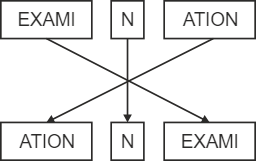
Similarly, for TENACIOUS, the middle letter is C.
Interchanging the positions of letters before and after the letter C, we get –
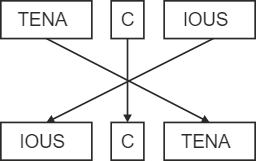
So, TENACIOUS can be written as IOUSCTENA in the code language. Hence, the third option is correct.
Q-2) Directions: If FATHER is coded as FBTIES, what should be the code for the word SISTER?
1) TJTUFS
2) SHSSEQ
3) SKSVET
4) SJSUES
Solution:
Add 0 and 1 alternatively to the place value of each letter of FATHER, to obtain the required code –
F + 0 = F; A + 1 = B; T + 0 = T; H + 1 = I; E + 0 = E; R + 1 = S
Thus, FATHER is coded as FBTIES.
Similarly, follow the same pattern for SISTER –
S + 0 = S; I + 1 = J; S + 0 = S; T + 1 = U; E + 0 = E; R + 1 = S
Thus, SISTER is coded as SJSUES. Hence, the fourth option is correct.
Coding-Decoding Questions for Bank IBPS CWE Clerk, IBPS RRB Clerk, SBI Assistant, Insurance Assistant exams
Q-1) Directions: In a certain code language, blue black green grey pink is written as mat fat tat bat gat, grey white orange green is written as hat gat nat fat, orange green pink grey is written as fat nat gat bat and violet blue red is written as tat lat dat. How is black written in that language?
1) tat
2) gat
3) fat
4) mat
Solution:
Given:
1. blue black green grey pink ⇒ mat fat tat bat gat
2. grey white orange green ⇒ hat gat nat fat
3. orange green pink grey ⇒ fat nat gat bat
4. violet blue red ⇒ tat lat dat
By comparing all the four coded sentences, we find that –
In sentences 1 and 2, grey and green are common words and gat and fat are common codes.
In sentences 1 and 3, pink and bat are common.
In sentences 1 and 4, blue and tat are common.
The remaining words and codes in sentence 1 are black and mat, in sentence 2 are white, orange and hat, nat, and in sentence 3 are violet, red and lat, dat.
So, black will be coded as mat. Hence, the fourth option is correct.
Q-2) Directions: In a certain code language, HALF is coded as 8041 and FLAG as 4980. What is the code for G in the given code language?
1) 4
2) 9
3) 0
4) 8
Solution:
Given:
1. HALF ⇒ 8041
2. FLAG ⇒ 4980
By comparing both the words and code, we find that –
Common letters – A, L, F and common codes – 0, 8, 4.
The remaining letter and the code in the word HALF are H and 1.
The remaining letters and the code in the word FLAG are G and 9.
So, G will be coded as 9. Hence, the second option is correct.
Q-3) Directions: In a certain code language, DOG is coded as 26 and BIN as 25. What will be the code for JAM in the given code language?
1) 25
2) 23
3) 24
4) 27
Solution:
Add the place values of the letters of the word DOG, to obtain the required code.
D→4; O→15; G→7
Add the place values→4 + 15 + 7 = 26
Thus, DOG is coded as 26.
And, BIN is coded as 25 –
B→2; I→9; N→14
Add the place values→2 + 9 + 14 = 25
Thus, BIN is coded as 25.
Similarly, follow the same pattern for JAM→
J→10; A→1; M→13
Now add the place values→10 + 1 + 13 = 24
Thus, JAM is coded as 24. Hence, the third option is correct.
For Non-Verbal reasoning read the topics below:
About the Faculty
Tanu Gupta, with over a decade of experience as a reasoning faculty, specializes in preparing students for various entrance examinations and career development. Her extensive work with multiple educational platforms and institutions has honed her expertise in logical and analytical thinking. Her dedication to innovative teaching methods ensures these articles provide practical insights and expert guidance.
Frequently Asked Questions (FAQs)
To tackle the questions related to coding-decoding, one has to remember the place values of all the alphabets and the opposite letter pairs. Also, practice more and more questions to be perfect in the particular topic.
In the SSC exams around 3-4 questions have been asked every year whereas in other exams like Railways, CUET or Defence mostly 2-3 questions have been asked.
The level of the questions of the dice has been seen as moderate to difficult in the examinations.
There are many relevant books where questions related to coding-decoding can easily be found. Also, there are some online sources where you can apply the mock exams to practice the questions.
The questions related to coding-decoding are asked in various competitive exams such as SSC, Bank PO, Bank Clerk, Railway, Defence, UPSC, State PCS, CUET, etc.
Coding Decoding in reasoning is based on encoding a letter, a number, or a word. Coding letters, numbers, or words is based on various rules and patterns. You have to decipher the correct pattern for the coded letters, numbers or words to solve the questions.
To learn how to solve coding decoding reasoning questions you have to read the article above as there are eight types of coding decoding and for each type you have to use the different method to solve the questions. In short form you have to find the answer according to the given codes in the questions like the letters are directly coded as letters with the help of different operations on the place value of the letters, such as addition, subtraction, etc you are able to get the required answer.
Example: In a certain code language, MAZZA is written as OBBAC and BLACK is written as DMCDM. How will FUZZY be written in that language?
Given:
MAZZA is written as OBBAC and BLACK is written as DMCDM.
Add 2 and 1 alternately to the place value of the letters of MAZZA and BLACK to obtain the required code –
M + 2 = O; A + 1 = B; Z + 2 = B; Z + 1 = A; A + 2 = C
Thus, MAZZA is coded as OBBAC.
B + 2 = D; L + 1 = M; A + 2 = C; C + 1 = D; K + 2 = M
Thus, BLACK is coded as DMCDM.
Similarly, follow the same pattern for FUZZY –
F + 2 = H; U + 1 = V; Z + 2 = B; Z + 1 = A; Y + 2 = A
So, FUZZY is coded as HVBAA.
The trick to solve reasoning questions is to do practice as much as possible. There are about 20 to 22 chapters in logical reasoning. For each chapter you have to learn basic concepts and you have to do practice to learn tricks. There is not a single trick to solve the reasoning questions.